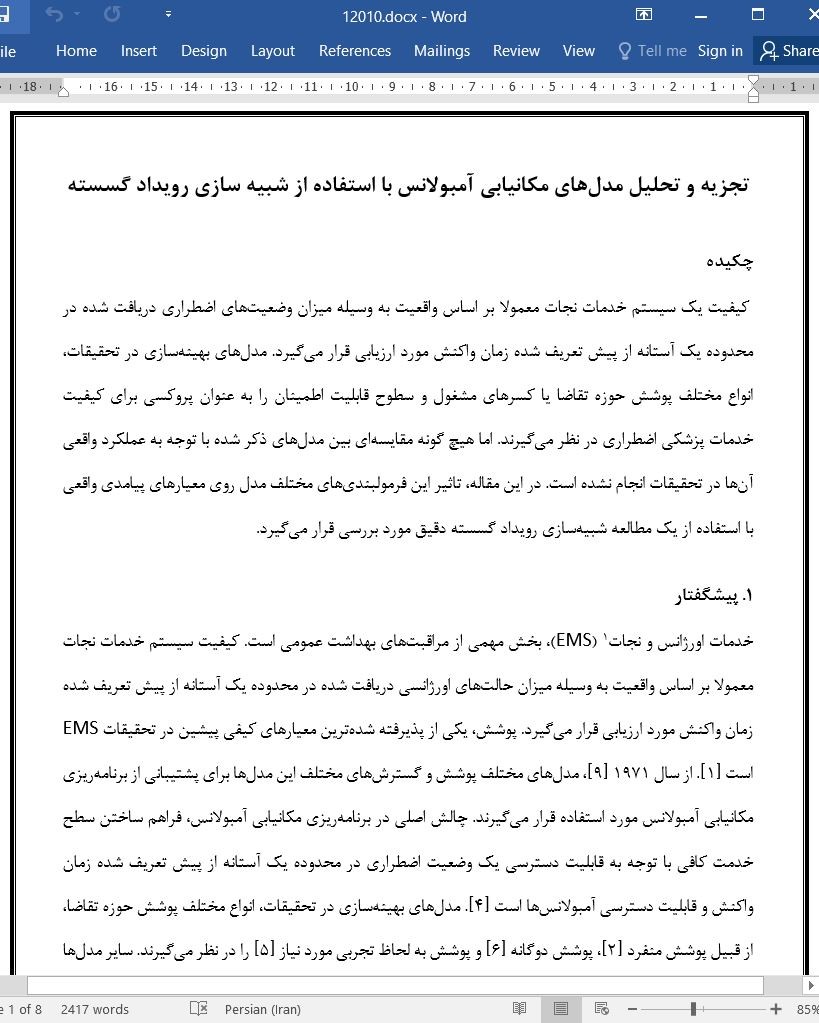
دانلود مقاله تجزیه و تحلیل مدلهای مکانیابی آمبولانس با استفاده از شبیه سازی رویداد گسسته
چکیده
کیفیت یک سیستم خدمات نجات معمولا بر اساس واقعیت به وسیله میزان وضعیتهای اضطراری دریافت شده در محدوده یک آستانه از پیش تعریف شده زمان واکنش مورد ارزیابی قرار میگیرد. مدلهای بهینهسازی در تحقیقات، انواع مختلف پوشش حوزه تقاضا یا کسرهای مشغول و سطوح قابلیت اطمینان را به عنوان پروکسی برای کیفیت خدمات پزشکی اضطراری در نظر میگیرند. اما هیچ گونه مقایسهای بین مدلهای ذکر شده با توجه به عملکرد واقعی آنها در تحقیقات انجام نشده است. در این مقاله، تاثیر این فرمولبندیهای مختلف مدل روی معیارهای پیامدی واقعی با استفاده از یک مطالعه شبیهسازی رویداد گسسته دقیق مورد بررسی قرار میگیرد.
5. نتیجهگیری و چشمانداز
در این مقاله، یک مطالعه شبیهسازی رویداد گسسته برای ارزیابی مدلهای مختلف مکانیابی آمبولانس انجام میشود. بر اساس این مطالعه شبیهسازی، نتایج نمونه مفاهیم پوششی مختلف مربوط به تاثیر آنها روی معیارهای عملکرد واقعی نشان داده شده است. همه مفاهیم مورد بررسی، در رابطه با پارامترهای ورودی و فرضیات مدل، متفاوت هستند. نتایج نمونه (مثالی) نشان میدهند که مدلهایی که نیاز به اطلاعات دقیق دارند (به عنوان مثال، MEXCLP و ERCP) دارای عملکرد بهتری نسبت به مدلهایی هستند که این اطلاعات را نادیده میگیرند. در گام بعدی، مطالعات در ساختارهای مختلف تقاضا و شهری معمول به طور سیستماتیک توسعه داده میشوند.
Abstract
The quality of a rescue service system is typically evaluated ex post by the proportion of emergencies reached within a predefined response time threshold. Optimization models in literature consider different variants of demand area coverage or busy fractions and reliability levels as a proxy for Emergency Medical Service quality. But no comparisons of the mentioned models with respect to their real-world performance are found in literature. In this paper, the influence of these different model formulations on real-world outcome measures is analyzed by means of a detailed discrete event simulation study.
5 Conclusion and Outlook
In this paper a discrete event simulation study is conducted to evaluate different ambulance location models. Based on the simulation study exemplary results of different coverage concepts concerning their influence on real world performance measures are shown. All analyzed concepts differ concerning the input parameters and model assumptions. Exemplary results suggest that models requiring detailed information (for example the MEXCLP and the ERCP) perform better than models ignoring these information. In the next step, studies are extended systematically to different typical city and demand structures.
چکیده
1. پیشگفتار
2. مدلهای مکانیابی آمبولانس
3. شبیهسازی رویداد گسسته سیستمهای EMS
4. مطالعه موردی و نتایج
5. نتیجهگیری و چشمانداز
منابع
Abstract
1 Introduction
2 Ambulance Location Models
3 Discrete Event Simulation of EMS Systems
4 Case Study and Results
5 Conclusion and Outlook
References
- ترجمه فارسی مقاله با فرمت ورد (word) با قابلیت ویرایش، بدون آرم سایت ای ترجمه
- ترجمه فارسی مقاله با فرمت pdf، بدون آرم سایت ای ترجمه



